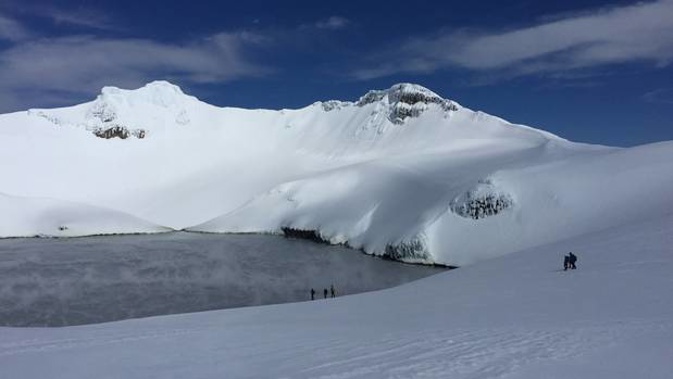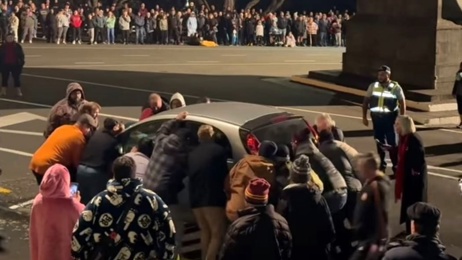
Iwi have placed a rāhui on the area around Mt Ruapehu where a man died after falling into Te Wai ā-moe (Crater Lake).
Emergency services flew to the scene of the accident about 1.50pm yesterday.
The man's body had already been retrieved from the lake by members of the climbing group he was part of when emergency services arrived.
Ruapehu iwi Uenuku, Ngāti Tūwharetoa and Ngāti Rangi this morning announced a rāhui, or temporary access ban, over the area to sunrise on Wednesday, September 26.
To show respect, all climbers, trampers and skiers are asked not to go above the boundaries of the ski areas at Whakapapa, Tūroa and Tukino, or above a line 2300m above sea level on the mountain.
In announcing the rāhui, the iwi acknowledged the death and expressed sympathy to the whānau of the deceased.
A rāhui (physical and spiritual protection mechanism) is a tool to manage human activity around a site where there has been loss of life.
It sets a temporary prohibition and limits access for that period, to ensure safety mechanisms are in place and provide time for tapu (sacredness) to dissipate following the death.
The rāhui is supported by the Department of Conservation and Ruapehu Alpine Lifts.
Police said in a statement the man's death would be referred to the Coroner.
Comments on the North Island Back Country Touring Facebook page said a person was rescued from Crater Lake in a "swift" and "successful" manner.
It was unclear if the man was alive when pulled from the lake.
Climber Hazel Phillips was at the scene of Crater Lake shortly after the accident and said she "partially witnessed the retrieval".
"Conditions were windy and icy underfoot near and this presents a sliding risk," she said.
"We also witnessed someone fall while descending Dome, lose his ice axe and thankfully come to a stop on a flat part of the Whakapapa Col.
"He was badly equipped and not experienced. He is lucky he did not end up in the crater lake too. With spring conditions softening the snow above the lifts on Ruapehu, this is a high-risk time as people who aren't used to serious alpine conditions begin to venture into unpatrolled and uncontrolled terrain.
"This is an incredibly sad outcome and a timely reminder for all backcountry snow users to ensure their skills are nailed and their gear is on point."
Another comment said a patroller had to go into the lake to help retrieve the man, who was already deceased.
Reports from the scene were that a group of climbers slipped near the "Pyramid" traverse of Mount Ruapehu, which is the high point of a circumnavigation around Crater Lake.
Herald reporter Martin Johnston was up at Crater Lake skiing around 1.30pm today, just before the accident reportedly occurred.
He said he suspected the man who died was part of a group of six climbers who he passed on his way down.
Johnston said he thought the group came up from Whakapapa ski field and climbed over a little peak called Dome.
"They would have walked off an icy face so they probably had crampons," Johnston said.
"Three of them went down near the edge of Crater Lake.
"It was very cold up there and conditions were firm and icy."
The small peak called Pyramid where the climber reportedly fell has a west-side cliff face that slopes steeply towards Crater Lake.
Chief executive of Ruapehu Alpine Lifts, Ross Copland, said some of his workers had assisted with the operation earlier this afternoon.
"Our company is the founding company of the Ruapehu Alpine Rescue Organisation, or Raro, so our senior patrollers were picked up by their helicopter to assist with the search."
RAL staffers had assisted with retrieving the body, as well as taking the man's two companions to the Whakapapa care clinic to be checked over.
Copland said the incident would not halt any lift operations, or result in closures as it happened outside of the skiing area.
It could, however, cause closures around Crater Lake itself.
The Department of Conservation had been notified, along with local Iwi.
Copland said the latter could choose to impose a rāhui at the site.
In August this year it was reported that the temperature of Crater Lake had been rising, reaching 30 degrees on August 11.
At the time, GeoNet however said the temperature changes were within the normal range and the existing alert level 1, signifying minor volcanic unrest, would remain.
In October 2017, New Zealand climber Richard Ebbett died after also falling into Crater Lake. Police said at the time it appeared the 30-year-old adventurer had slipped and fallen into the lake. Ebbett had earlier been in the news, after saving a young girl from drowning in 2001.
GNS volcano information specialist Brad Scott said on August 28 Crater Lake was overflowing, but that this was "expected activity".
"Since 2003, the lake has undergone 15 heating-cooling cycles and no eruptions have occurred when the lake temperature is high. The two small eruptions since 2003 were from a cooler lake," Scott said.
Take your Radio, Podcasts and Music with you









